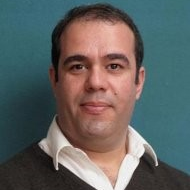Advanced Microwave Dielectric Materials
A special issue of Crystals (ISSN 2073-4352). This special issue belongs to the section "Crystal Engineering".
Deadline for manuscript submissions: 5 October 2024 | Viewed by 101
Special Issue Editor
Interests: multiferroics; ferroelectrics; piezoelectrics; energy storage; ceramics; microwave resonators; NTC thermistors; thermoelectrics; sensors; actuators; semiconductor oxides; photoferroelectrics; perovskite oxides; lead free ceramics; AC impedance; electron microscopy; processing of ceramics
Special Issues, Collections and Topics in MDPI journals
Special Issue Information
Dear Colleagues,
For decades, wireless communication systems rely on advanced microwave dielectric materials. For many years, the research and commercialisation of microwave dielectrics were solely focused on temperature-stable, high-relative permittivity ceramics with ultralow losses, used in the base stations of 2G and 3G systems, whereas the 4G technology employed metallised ceramic rods for filters. 5G and forthcoming 6G communication systems require dielectric ceramics exhibiting low relative permittivity and near-zero temperature coefficients of resonant frequency for the lower part of the microwave band and at the sub-terahertz level. Currently, microwave dielectrics are used as filters in base stations, whereas acoustic wave filters are used in handheld devices. Nevertheless, there is an urgent demand for inexpensive antennas and low permittivity dielectrics to improve efficiency and bandwidth. Polymers and ceramic-filled polymers are emerging as serious contenders as they offer the possibility to meet both cost and technical requirements, in addition to their ability to be easily integrated with the established low temperature processes. Nevertheless, ceramics still offer the advantages of lower dielectric losses, temperature-stable relative permittivity, and a wider range of relative permittivity values in addition to better thermal management and mechanical stability. One also would expect new materials entering the arena of wireless communications, such as magnetic oxide circulators, ceramics in polymer matrices, GaN-on-diamond, and others. This Special Issue is devoted to advanced microwave dielectric materials for wireless communications.
Dr. Antonio Feteira
Guest Editor
Manuscript Submission Information
Manuscripts should be submitted online at www.mdpi.com by registering and logging in to this website. Once you are registered, click here to go to the submission form. Manuscripts can be submitted until the deadline. All submissions that pass pre-check are peer-reviewed. Accepted papers will be published continuously in the journal (as soon as accepted) and will be listed together on the special issue website. Research articles, review articles as well as short communications are invited. For planned papers, a title and short abstract (about 100 words) can be sent to the Editorial Office for announcement on this website.
Submitted manuscripts should not have been published previously, nor be under consideration for publication elsewhere (except conference proceedings papers). All manuscripts are thoroughly refereed through a single-blind peer-review process. A guide for authors and other relevant information for submission of manuscripts is available on the Instructions for Authors page. Crystals is an international peer-reviewed open access monthly journal published by MDPI.
Please visit the Instructions for Authors page before submitting a manuscript. The Article Processing Charge (APC) for publication in this open access journal is 2600 CHF (Swiss Francs). Submitted papers should be well formatted and use good English. Authors may use MDPI's English editing service prior to publication or during author revisions.
Keywords
- LTCC
- microwave resonator
- circulator
- gallium nitride
- 5G/6G ceramics





